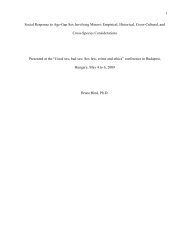Infant and Child Sexuality: A Sociological Perspective - Ipce
Infant and Child Sexuality: A Sociological Perspective - Ipce
Infant and Child Sexuality: A Sociological Perspective - Ipce
Create successful ePaper yourself
Turn your PDF publications into a flip-book with our unique Google optimized e-Paper software.
PREFACE<br />
We know very little about sexual experiences of children. There are<br />
many reasons for this, not the least is the fact that until recently we<br />
have not admitted, <strong>and</strong> have not wanted to admit, that “normal” children<br />
have sexual experiences. Freud alerted us to the sexual potentialities<br />
of the young, but still we were loath to research the subject.<br />
We need not <strong>and</strong> should not wait longer in researching the sexual<br />
potential <strong>and</strong> sexual experiences of normal children, though there will<br />
be pockets of resistance. The rewards will be greater than the fears<br />
<strong>and</strong> threats that will accompany inquiry <strong>and</strong> free discussion. Sexually<br />
speaking, what are the young capable of experiencing? What are they<br />
experiencing? Many parents, teachers, <strong>and</strong> others interested in childhood<br />
<strong>and</strong> the effect of childhood experiences on adult life will appreciate<br />
such inquiry.<br />
This is such a study, albeit an exploratory one. It addresses<br />
itself to the following questions. At how young an age do children have<br />
the capacity to engage in sexual experiences? What kinds of experiences<br />
do the young have with each other as well as with persons older<br />
than themselves? What are the consequences of these encounters for the<br />
young?<br />
This is not the first time these questions have been asked. In the<br />
past they have been dealt with largely within a psychoanalytical conceptual<br />
framework. The conceptual framework used here is sociological,<br />
focusing on the affectional, <strong>and</strong> more especially the sexual, encounters<br />
of the young with other persons. What little sociological study<br />
there has been has been of a survey nature, reporting on the incidence<br />
of various sexual phenomena. And most surveys have been directed at the<br />
experiences of none younger than the adolescent. These surveys answer<br />
such questions as, At what age does dating begin? What is the incidence<br />
of premarital intercourse, et cetera? On the other h<strong>and</strong>, there is<br />
a paucity of survey <strong>and</strong> in-depth studies of the affectional encounters<br />
of infants, children, <strong>and</strong> preadolescents. This is especially true of<br />
encounters as seen from the perspective of the young participant. Surveys<br />
as “slices of data” are valuable in showing how prevalent various<br />
kinds of behavior are, but taken alone, they oversimplify the picture.<br />
They tell us little or nothing about how the subjects (in this case the<br />
children) define <strong>and</strong> experience their situations. By letting the young<br />
speak for themselves regarding the nature of affectional encounters,<br />
the interaction of the participants, <strong>and</strong> the consequences, we hope to<br />
add a quality to the knowledge of encounters of the young.<br />
In beginning any research project one makes a thorough search of<br />
the literature, especially looking for data from the researches of others<br />
who have utilized a compatible conceptual framework. The search for<br />
data on affectional-sexual encounters of infants, children, <strong>and</strong> preadolescents<br />
has been made, <strong>and</strong> the findings, mostly from surveys, are<br />
incorporated along with new case data in the chapters to follow.<br />
vi
















